【研究意义】三豆饮方记载于《证治准绳》《本草纲目》等古籍中,由黑豆、绿豆、赤小豆(或代以黄豆)组成,历代医家多将此方用于治疗痘疹、疮毒之症。目前有文献报道三豆饮用于治疗痤疮、疱疹[1]、黄褐斑[2]等皮肤病,疗效良好,对小儿高热[3-4]、肾病综合征[5]、急性中毒[6]等也有较好疗效。现代药理实验研究也表明,三豆饮具有抗氧化[7-8]、降血糖[9-11]等作用。基于三豆饮的良好治疗和保健作用,课题组前期将其制备成三豆饮功能饮料,后期剩余大量豆渣,其含有丰富的膳食纤维(Dietary fiber,DF)。研究三豆饮膳食纤维提取工艺,对三豆饮豆渣的循环利用、增加植物膳食纤维种类、改善居民饮食结构有理论指导和实际应用意义。
【研究进展】膳食纤维有第七营养素的美称,由水溶性膳食纤维和水不溶性膳食纤维组成,主要包括纤维素、半纤维素、果胶等物质,食用后不能被人体消化[12]。研究表明,膳食纤维具有降血脂、降血糖、降血压、预防便秘、减肥、抗氧化等药理作用,能促进肠道蠕动,加速毒害物质排出,在一定程度上降低人们发病几率[13-14]。膳食纤维还具有发酵性,可使肠道pH值发生改变,促进有益菌群生长,破坏腐生菌生存环境,能预防肠道粘膜发生萎缩,有效维持维生素代谢[15-16];此外,膳食纤维还具有持水性和膨胀性、吸附作用[17-19]和阳离子交换作用[20]等。持水性和吸水膨胀性使膳食纤维在胃肠道中体积变大后成为填充剂,并且影响碳水化合物等在肠道内的消化吸收,有利于减肥[21];膳食纤维分子表面具有较多的活性基团,使之具有吸附作用,能够吸附胆酸钠、胆固醇和多种有毒成分,可降低心血管疾病的发生率[22-25]。目前纤维食品已经成为国际食品结构调整的主流方向,其需求在美国和日本以每年10%速度增长。
【本研究切入点】基于膳食纤维具有较好的营养品质[26-31],本研究针对三豆饮制备过程中残余的豆渣进行再利用,对三豆饮豆渣中的水分、灰分、脂肪、蛋白质、膳食纤维等主要成分进行测定。【拟解决的关键问题】为减少资源浪费,本研究利用单因素试验结合Box-behnken法对三豆饮豆渣中膳食纤维进行酸-碱提取工艺研究,为三豆饮豆渣开发利用提供理论依据。
1 材料与方法
1.1 试验材料
黑豆〔Glycine max(L.) Merr〕、赤小豆(Vigna umbellata Ohwi et Ohashi)、绿豆〔Vigna radiata(Linn.) Wilczek〕购自重庆慧远药业有限公司;盐酸(化学纯) 购自重庆川东化工有限公司,氢氧化钠(化学纯) 购自成都金山化学试剂有限公司,其余试剂均为分析纯。
主要仪器:101-1型电热恒温鼓风干燥箱(上海路达实验仪器有限公司)、DK-98-Ⅱ型电热恒温水浴锅(天津市泰斯特仪器有限公司)、PHS-3C pH计(上海仪电科学仪器股份有限公司)、SX-4-10型箱式电阻炉(天津市泰斯特仪器有限公司)、SC083139型实验室超纯水设备(四川沃特尔水处理设备有限公司)。
1.2 试验方法
1.2.1 工艺流程 称取黑豆、赤小豆、绿豆→加水提取3次→过滤,取豆渣烘干,粉碎过筛→加酸水处理→洗涤抽滤→干燥粉碎→加碱水处理→洗涤抽滤→干燥粉碎→获得豆渣膳食纤维。
1.2.2 三豆饮豆渣中基本成分测定 等比例称取黑豆、赤小豆、绿豆药材,均匀混合,加适量蒸馏水,提取3次,过滤,合并三豆饮提取液(制备功能饮料用),豆渣烘干,粉碎过孔径250±9.9μm的筛,测定膳食纤维、脂肪、蛋白质、水分、灰分等主要成分含量。脂肪含量采用索氏提取法参照GB 5009.6-2016测定[32],蛋白质含量参照GB5009.5-2016测定[33],水分含量参照GB5009.3-2016测定[34];灰分含量参照 GB5009.4-2016测定[35];膳食纤维含量参照GB/T 5009.88-2008测定[36]。
1.2.3 三豆饮豆渣中膳食纤维酸提工艺建立 (1)单因素试验设计[37-38]:精密称取三豆饮烘干豆渣5 g,根据表1试验条件分别考察不同酸提料液比、酸提温度、酸提pH、酸提时间对三豆饮豆渣中膳食纤维含量的影响,确定酸提工艺最佳料液比、最佳酸提温度、最佳酸提pH、最佳酸提时间范围。
表1 酸提工艺单因素对三豆饮豆渣中膳食纤维含量的影响试验设计
Table 1 Experimental design for effect of single factor of acid extraction test on the content of dietary fiber from Sandouyin bean dregs

单因素试验Single factor test酸提温度Acid extraction temperature(℃)酸提pH Acid extraction pH酸提料液比Acid extraction solid-liquid ratio(g/mL)酸提时间Acid extraction time(h)酸提料液比试验Acid extraction water/solid ratio test 85 3.9 1∶5、1∶10、1∶15、1∶20、1∶25、1∶30、1∶35 2.5酸提温度试验Acid extraction temperature test 70、75、80、85、90、95、100 3.9 1∶ 20 2.5酸提pH试验Acid extraction pH test 85 3.0、3.3、3.6、3.9、4.2、4.5、4.8 1∶20 2.5酸提时间试验Acid extraction time test 85 3.9 1∶ 20 1.0、1.5、2.0、2.5、3.0、3.5、4.0
(2)响应面法优化酸提工艺[39-40]:根据单因素试验结果,以酸提pH(A)、酸提料液比(B)、酸提温度(C)、酸提时间(D)为自变量,以三豆饮中膳食纤维含量为响应值,用Design-Expert 8.0.6软件在四因素三水平上对三豆饮豆渣中膳食纤维提取过程进行优化,以达到最大限度提取的目的。试验设计因素水平及编码如表2所示。
1.2.4 三豆饮豆渣中膳食纤维碱提工艺建立(1)单因素试验设计。精密称取三豆饮烘干豆渣5 g,根据表3试验条件分别考察不同碱提料液比、碱提温度、碱提pH、碱提时间对三豆饮豆渣中膳食纤维含量的影响,确定碱提工艺最佳料液比、最佳碱提温度、最佳碱提pH、最佳碱提时间范围。(2)响应面法优化碱提取工艺。根据单因素试验结果,以碱提pH(A)、碱提温度(B)、碱提时间(C)、碱提料液比(D)为自变量,以三豆饮中膳食纤维含量为响应值,用Design-Expert 8.0.6软件在四因素三水平上对三豆饮豆渣中膳食纤维提取过程进行优化,以达到最大限度提取的目的。试验设计因素水平及编码如表4所示。
表2 酸提工艺响应面分析因素与水平编码
Table 2 Factors and levels of response surface design of acid extraction test

因素Factors水平Levels 酸提pH Acid extraction pH酸提料液比(g/mL)Acid extraction solid-liquid ratio酸提温度(℃)Acid extraction temperature(℃)酸提时间(h)Acid extraction time(h)-1 4.2 1∶15 80 2 0 4.5 1∶20 85 2.5 1 4.8 1∶25 90 3
表3 碱提工艺单因素对三豆饮豆渣中膳食纤维含量的影响试验
Table 3 Experimental design for effect of single factor of alkali extraction test on the content of dietary fiber from Sandouyin bean dregs

碱提时间Alkali extraction time(h)碱提料液比试验Alkali extraction water/solid ratio test单因素试验Single factor test碱提温度Alkali extraction temperature(℃)碱提pH Alkali extraction pH碱提料液比Alkali extraction solid-liquid ratio(g/mL)50 10.9 1∶ 5、1∶ 10、1∶ 15、1∶ 20、1∶ 25、1∶ 30、1∶35 2.5碱提温度试验Alkali extraction temperature test 35、40、45、50、55、60、65 10.9 1∶ 20 2.5碱提pH试验Alkali extraction pH test 1∶20 2.5碱提时间试验Alkali extraction time test 50 10.0、10.3、10.6、10.9、11.2、11.5、11.8 50 10.9 1∶ 20 1.0、1.5、2.0、2.5、3.0、3.5、4.0
表4 碱提工艺响应面分析因素与水平编码
Table4 Factors and levels of response surface design of alkali extraction test

水平Levels碱提pH Alkali extraction pH碱提温度Alkali extraction temperature(℃)碱提时间Alkali extraction time(h)碱提料液比Alkali extraction solid-liquid ratio(g/mL)-1 11.2 50 3.0 1∶25 0 11.5 55 3.5 1∶30 1 11.8 60 4.0 1∶35
2 结果与分析
2.1 三豆饮豆渣中基本成分含量
本研究对三豆饮豆渣基本成分进行测定,结果表明,豆渣中含膳食纤维45.6%、蛋白质36.55%、水分9.6%、脂肪6.5%、灰分1.75%。可见,豆渣中的膳食纤维含量相对较低,不适合作为人体膳食纤维补充剂,需要对豆渣中膳食纤维进行提取富集。
2.2 酸提三豆饮豆渣中膳食纤维单因素试验结果
2.2.1 酸提料液比对三豆饮豆渣中膳食纤维含量的影响 采用三豆饮豆渣酸提工艺,在提取温度85 ℃、提取pH 3.9、提取时间2.5 h条件下,料液比在1∶5~1∶25区间豆渣中膳食纤维含量持续增多,1∶25后膳食纤维含量基本稳定,其中在1∶15~1∶25之间增长速度较快(图1),故选取酸提料液比为1∶15、1∶20、1∶25用于后续酸提响应面法试验。
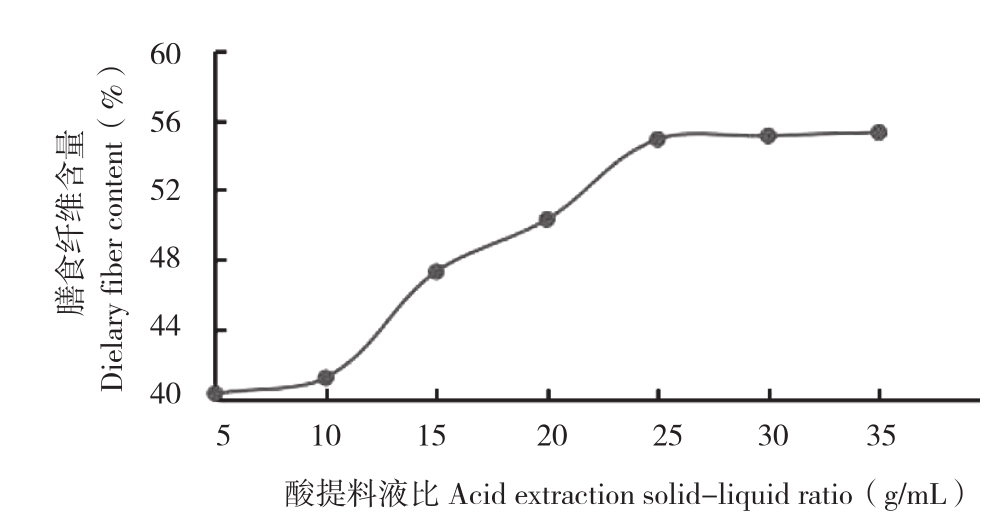
图1 酸提料液比对三豆饮豆渣中膳食纤维含量的影响
Fig. 1 Effect of solid-liquid ratio of acid extraction on the content of dietary fiber from Sandouyin soybean dregs
2.2.2 酸提温度对三豆饮豆渣中膳食纤维含量的影响 采用三豆饮豆渣酸提工艺,在料液比1∶20、提取pH3.9、提取时间2.5 h条件下,提取温度在70~85℃区间豆渣中膳食纤维含量快速增加,温度超过85℃以后豆渣中膳食纤维含量快速减少,其中在80~85℃时增长速度最快(图2),故选取酸提温度80、85、90℃用于后续酸提响应面法试验。
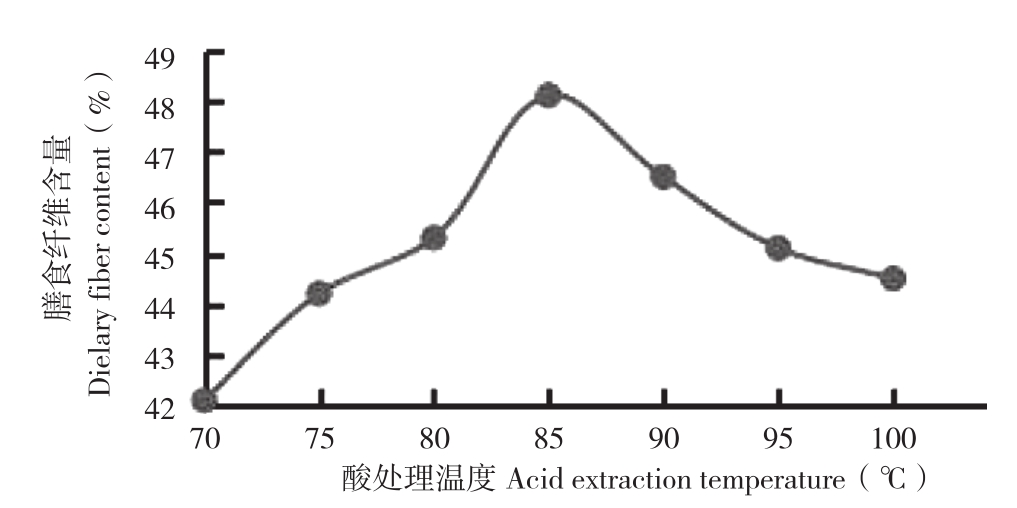
图2 酸提温度对三豆饮豆渣中膳食纤维含量的影响
Fig. 2 Effect of acid extraction temperature on the content of dietary fiber from Sandouyin soybean dregs
2.2.3 酸提pH对三豆饮豆渣中膳食纤维含量的影响 采用三豆饮豆渣酸提工艺,在料液比为1∶20、提取温度为85 ℃、提取时间为2.5 h条件下,提取pH在3.0~4.5区间豆渣中膳食纤维含量持续增多,高于4.5含量降低,其中在4.2~4.5时增长速度最快(图3),故选取酸提pH 4.2、4.5、4.8用于酸提响应面法试验。
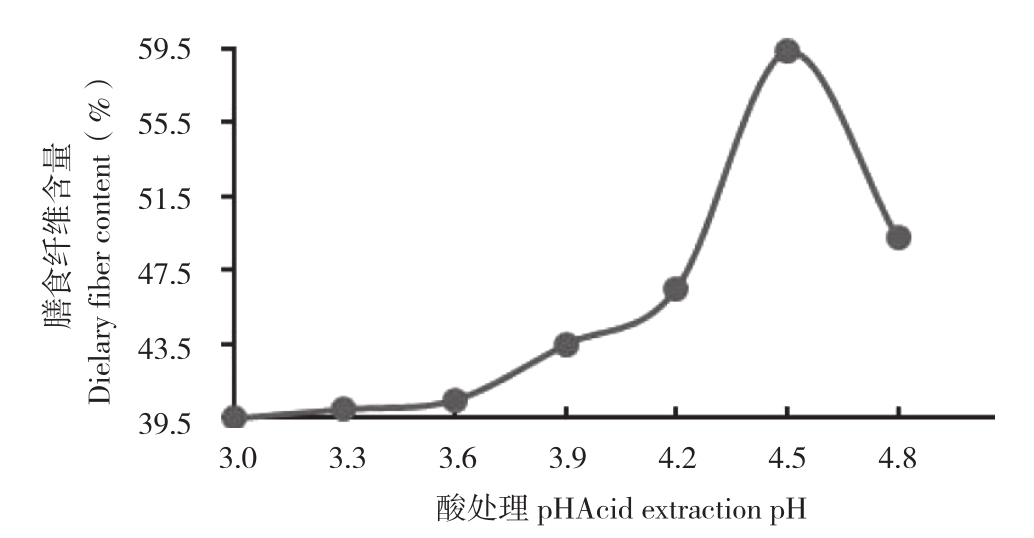
图3 酸提pH对三豆饮豆渣中膳食纤维的影响
Fig. 3 Effect of acid extraction pH on the content of dietary fiber from Sandouyin soybean dregs
2.2.4 酸提时间对三豆饮豆渣中膳食纤维含量的影响 采用三豆饮豆渣酸提工艺,在料液比为1∶20、提取温度为85℃、提取pH为3.9条件下,提取时间在1~3 h区间豆渣中膳食纤维含量持续增加,在提取时间为2.5 h后达到相对平衡(图4),故选取酸提时间为2.0、2.5、3.0 h用于酸提响应面法试验。

图4 酸提时间对三豆饮豆渣中膳食纤维含量的影响
Fig. 4 Effect of acid extraction time on the content of dietary fiber from Sandouyin soybean dregs
表5 酸提响应面设计及结果
Table 5 RSM design matrix and the responses of acid extraction
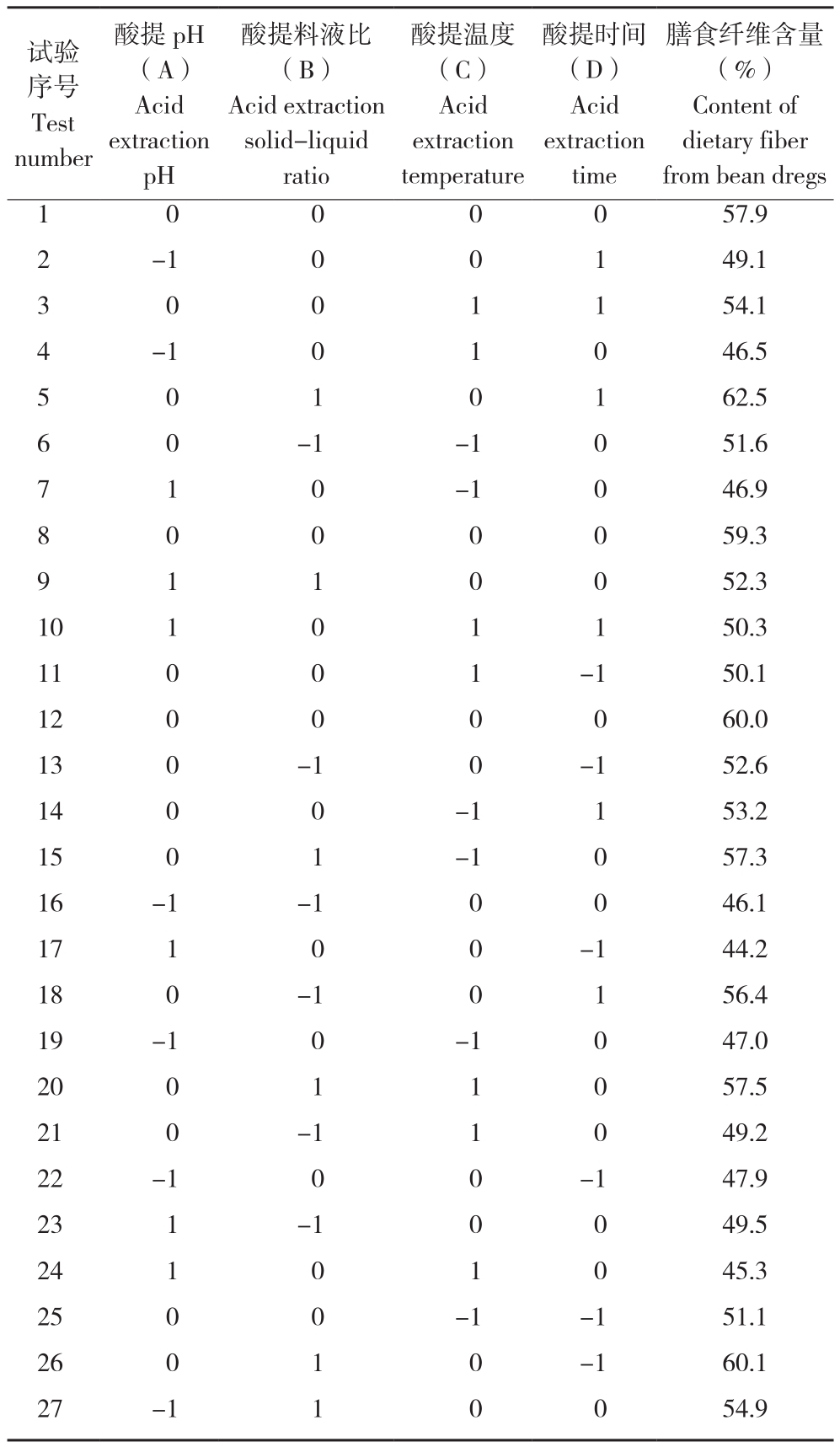
试验序号Test number酸提pH(A)Acid extraction pH酸提料液比(B)Acid extraction solid-liquid ratio酸提温度(C)Acid extraction temperature酸提时间(D)Acid extraction time膳食纤维含量(%)Content of dietary fiber from bean dregs 1 0 0 0 0 57.9 2 -1 0 0 1 49.1 3 0 0 1 1 54.1 4 -1 0 1 0 46.5 5 0 1 0 1 62.5 6 0 -1 -1 0 51.6 7 1 0 -1 0 46.9 8 0 0 0 0 59.3 9 1 1 0 0 52.3 10 1 0 1 1 50.3 11 0 0 1 -1 50.1 12 0 0 0 0 60.0 13 0 -1 0 -1 52.6 14 0 0 -1 1 53.2 15 0 1 -1 0 57.3 16 -1 -1 0 0 46.1 17 1 0 0 -1 44.2 18 0 -1 0 1 56.4 19 -1 0 -1 0 47.0 20 0 1 1 0 57.5 21 0 -1 1 0 49.2 22 -1 0 0 -1 47.9 23 1 -1 0 0 49.5 24 1 0 1 0 45.3 25 0 0 -1 -1 51.1 26 0 1 0 -1 60.1 27 -1 1 0 0 54.9
2.3 酸提响应面法优化提取工艺
2.3.1 酸提三豆饮豆渣中膳食纤维的回归方程方差分析及显著性检验 利用Design-Expert 8.0.6软件对表5试验数据进行二次多项式回归拟合,得到酸提膳食纤维含量对酸提pH(A)、酸提料液比(B)、酸提温度 (C)、酸提时间(D)的数学回归模型为:
膳食纤维含量(%)=59.07-0.25A+3.26B-0.36C+1.63D-1.50AB-0.28AC+1.22AD+0.66BC-0.35BD+0.47CD-8.52A2+0.22B2-4.80C2-2.07D2
2.3.2 酸提三豆饮豆渣中膳食纤维的回归方差分析及显著性检验 对上述模型进行方差分析,结果(表6)表明,试验模型的P值小于0.0001,说明模型极显著;P失拟项=0.6509>0.05,表明试验外的其他因素对本研究影响小;模型R2为98.24%,表明各单因素与膳食纤维含量之间关系显著。酸提料液比为极显著,且由F值可知,酸提料液比对膳食纤维含量的影响最大,其次是酸提时间,再次是酸提温度,最后是酸提pH。
表6 酸提膳食纤维回归方程模拟显著性分析
Table 6 Significance analysis on regression equation model of dietary fiber extracted by acid
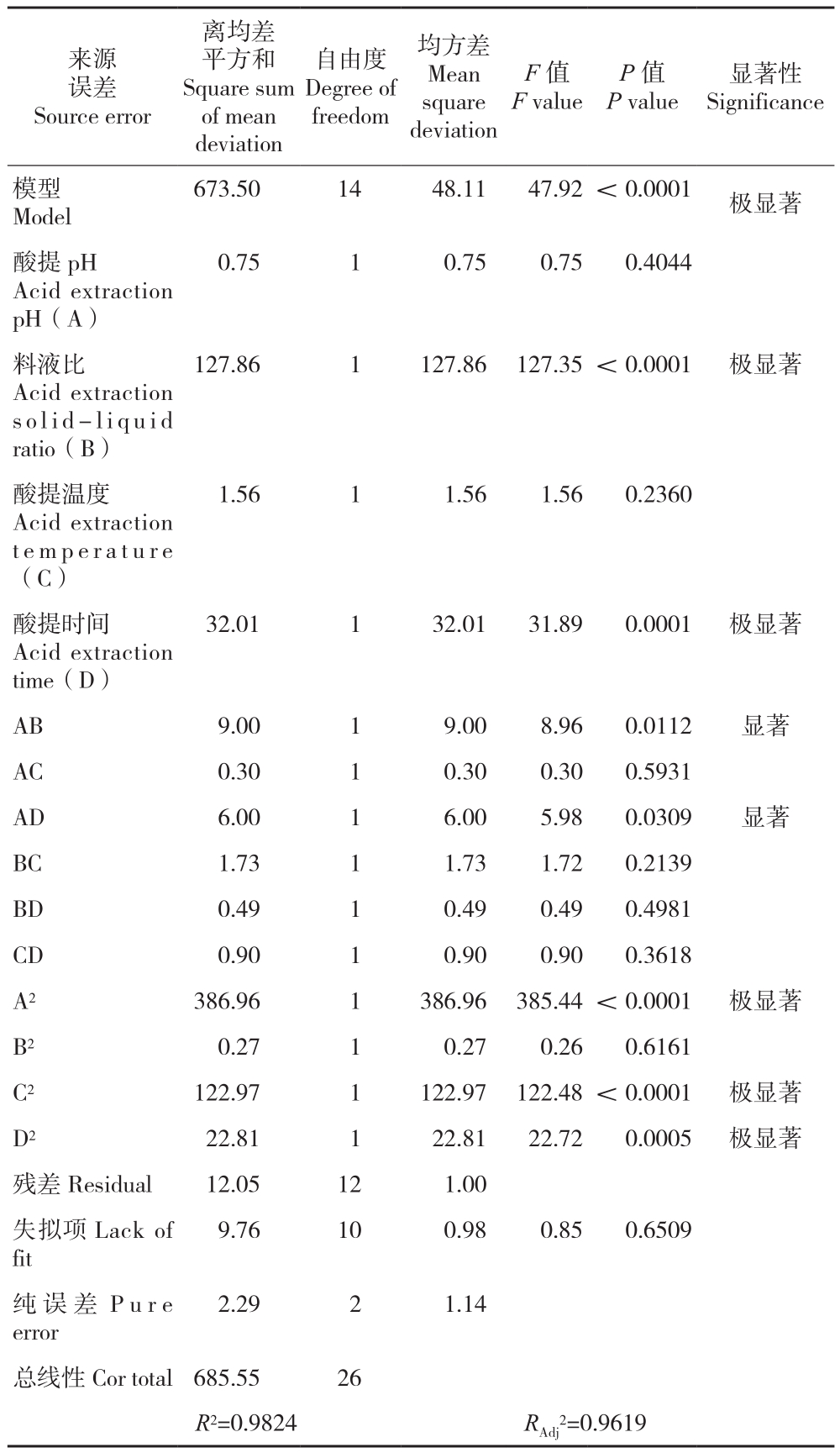
来源误差Source error离均差平方和Square sum of mean deviation自由度Degree of freedom均方差Mean square deviation F值F value P值P value显著性Significance模型Model 673.50 14 48.11 47.92<0.0001 极显著酸提pH Acid extraction pH(A)0.75 1 0.75 0.75 0.4044料液比Acid extraction solid-liquid ratio(B)127.86 1 127.86 127.35<0.0001 极显著酸提温度Acid extraction temperature(C)1.56 1 1.56 1.56 0.2360酸提时间Acid extraction time(D)32.01 1 32.01 31.89 0.0001 极显著AB 9.00 1 9.00 8.96 0.0112 显著AC 0.30 1 0.30 0.30 0.5931 AD 6.00 1 6.00 5.98 0.0309 显著BC 1.73 1 1.73 1.72 0.2139 BD 0.49 1 0.49 0.49 0.4981 CD 0.90 1 0.90 0.90 0.3618 A2 386.96 1 386.96 385.44<0.0001 极显著B2 0.27 1 0.27 0.26 0.6161 C2 122.97 1 122.97 122.48<0.0001 极显著D2 22.81 1 22.81 22.72 0.0005 极显著残差Residual 12.05 12 1.00失拟项Lack of fit 9.76 10 0.98 0.85 0.6509纯误差Pure error 2.29 2 1.14总线性Cor total 685.55 26 R2=0.9824 RAdj2=0.9619

图5 酸提三豆饮豆渣中膳食纤维的响应面图(左)和等高线图(右)
Fig. 5 Acid extraction of dietary fiber from Sandouyin bean dregs in the response surface (Left) and contour plot (Right)
2.3.3 酸提膳食纤维响应面图分析 由酸提三豆饮豆渣中膳食纤维的响应面(图5)可知,随着酸提pH、酸提温度、酸提料液比、酸提时间的增加,三豆饮豆渣中膳食纤维含量呈现先增加后减小的趋势,且酸提料液比的曲线较陡,对响应值的影响最为显著,其次为酸提pH和酸提温度,而酸提时间对响应值最小,表现为曲线平缓。由图5中酸提料液比和酸提温度的等高线排列紧密且趋向椭圆形可得出,酸提料液比和酸提温度交互作用最大;酸提pH和酸提温度的等高线排列稀疏呈圆形,表明酸提pH和酸提温度的交互作用最小。
2.3.4 酸提工艺条件的验证 通过对试验模型的分析得到三豆饮豆渣中膳食纤维酸提的最佳条件为:酸提 pH 4.6、料液比1∶25(g/mL)、酸提时间2.8 h、酸提温度87℃,获得三豆饮豆渣中膳食纤维含量为59.0%,试验重复3次验证,膳食纤维提取量分别为58.9%、59.3%、59.1%,其平均提取量为59.1%,与理论值偏差小于0.01%,比原三豆饮豆渣中膳食纤维含量增加14.4%。表明通过响应面设计优化后得到的最佳条件参数可靠,能较好地预测试验得率。
2.4 碱提三豆饮豆渣中膳食纤维单因素试验结果
2.4.1 碱提料液比对三豆饮豆渣中膳食纤维含量的影响 从图6可见,采用三豆饮豆渣碱提工艺,在碱提温度50℃、碱提时间2.5 h、碱提pH 10.9条件下,料液比在1∶5~1∶30区间豆渣中膳食纤维含量持续增加,1∶30后豆渣中膳食纤维含量基本稳定,其中在1∶25~1∶30之间增长速度较快,故选择碱提料液比1∶25、1∶30、1∶35用于后续碱提响应面法试验。

图6 碱提料液比对三豆饮豆渣中膳食纤维含量的影响
Fig. 6 Effect of solid/liquid on alkali extraction of dietary fiber from Sandouyin soybean dregs
2.4.2 碱提pH对三豆饮豆渣中膳食纤维含量的影响 采用三豆饮豆渣碱提工艺,在碱提料液比1∶20、碱提时间2.5 h、碱提温度50℃条件下,提取pH在10.0~11.5区间豆渣中膳食纤维含量持续增加,pH高于11.5豆渣中膳食纤维含量降低(图7),故选取碱提pH 11.2、11.5、11.8用于后续碱提响应面法试验。
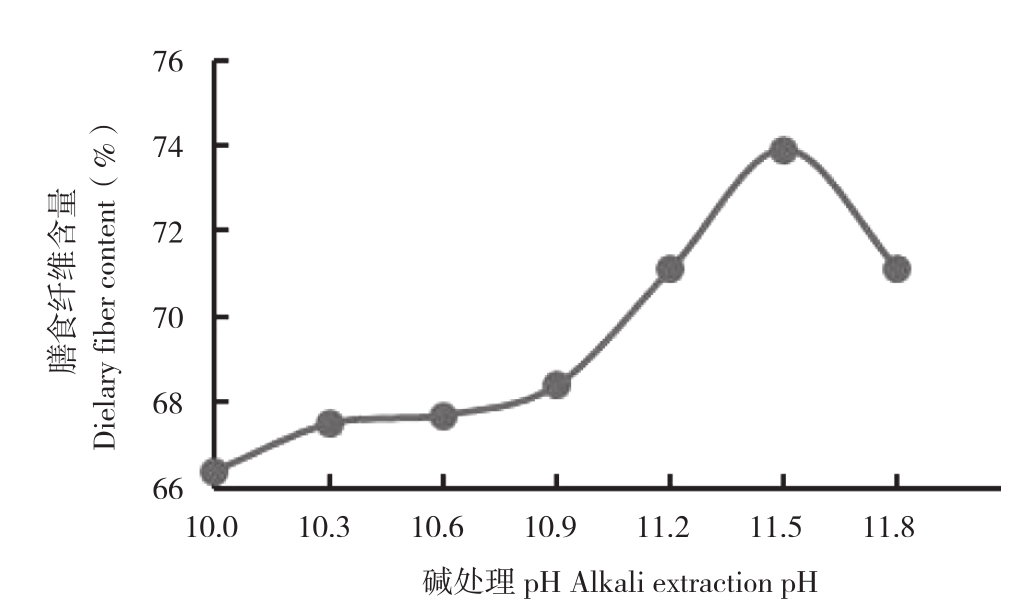
图7 碱提pH对三豆饮豆渣中膳食纤维含量的影响
Fig.7 Effect of alkali extraction pH on the content of dietary fiber from Sandouyin soybean dregs
2.4.3 碱提时间对三豆饮豆渣中膳食纤维含量的影响 采用三豆饮豆渣碱提工艺,在碱提料液比1∶20、碱提pH 10.9、碱提温度50℃条件下,碱提时间在1.0~3.5 h区间豆渣中膳食纤维含量持续增加,3.5 h后豆渣中膳食纤维含量基本稳定,其中在3.0~3.5 h之间增长速度较快(图8),故选取碱提时间3.0、3.5、4.0 h用于后续碱提响应面法试验。
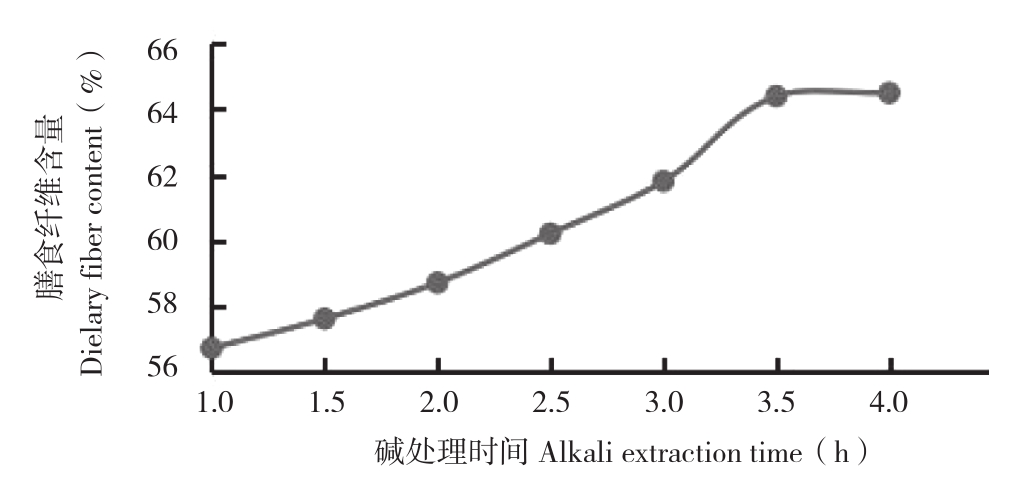
图8 碱提时间对三豆饮豆渣中膳食纤维含量的影响
Fig. 8 Effect of alkali extraction time on the content of dietary fiber from Sandouyin soybean dregs
2.4.4 碱提温度对三豆饮豆渣中膳食纤维含量的影响 采用三豆饮豆渣碱提工艺,在碱提料液比1∶20、碱提时间2.5 h、碱提pH 10.9条件下,碱提温度在35~55℃区间豆渣中膳食纤维含量持续增加,高于55℃豆渣中膳食纤维含量降低(图9),故选取碱提温度50、55、60℃用于后续碱提响应面法试验。

图9 碱提温度对三豆饮豆渣中膳食纤维含量的影响
Fig. 9 Effect of alkali extraction temperature on the content of dietary fiber from Sandouyin soybean dregs
2.5 碱提响应面法优化提取工艺
2.5.1 碱提三豆饮豆渣中膳食纤维的回归方程方差分析及显著性检验 利用Design-Expert 8.0.6软件对表7试验数据进行二次多项式回归拟合,得到碱提膳食纤维含量对碱提pH(A)、碱提温度 (B)、碱提时间(C)、碱提料液比(D)、的数学回归模型为:
表7 碱提响应面设计及结果
Table 7 RSM design matrix and the responses of alkali extraction
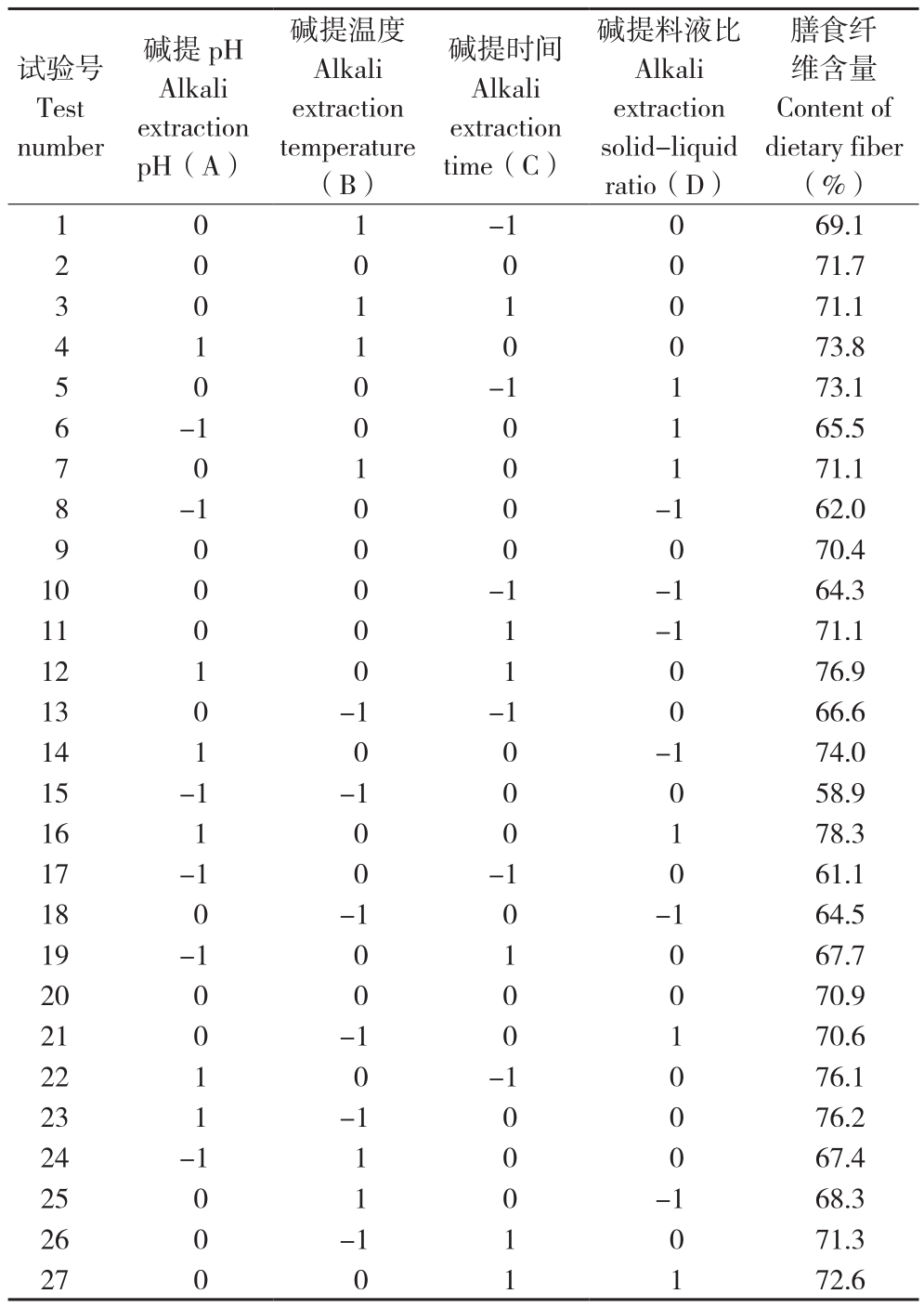
试验号Test number碱提pH Alkali extraction pH(A)碱提温度Alkali extraction temperature(B)碱提时间Alkali extraction time(C)碱提料液比Alkali extraction solid-liquid ratio(D)膳食纤维含量Content of dietary fiber(%)1 0 1 -1 0 69.1 2 0 0 0 0 71.7 3 0 1 1 0 71.1 4 1 1 0 0 73.8 5 0 0 -1 1 73.1 6 -1 0 0 1 65.5 7 0 1 0 1 71.1 8 -1 0 0 -1 62.0 9 0 0 0 0 70.4 10 0 0 -1 -1 64.3 11 0 0 1 -1 71.1 12 1 0 1 0 76.9 13 0 -1 -1 0 66.6 14 1 0 0 -1 74.0 15 -1 -1 0 0 58.9 16 1 0 0 1 78.3 17 -1 0 -1 0 61.1 18 0 -1 0 -1 64.5 19 -1 0 1 0 67.7 20 0 0 0 0 70.9 21 0 -1 0 1 70.6 22 1 0 -1 0 76.1 23 1 -1 0 0 76.2 24 -1 1 0 0 67.4 25 0 1 0 -1 68.3 26 0 -1 1 0 71.3 27 0 0 1 1 72.6
膳食纤维含量(%)=71.00+6.07A+1.07B+1.70C+2.24D-2.71AB-1.45AC+0.21AD-0.67BC-0.82BD-1.82CD-0.41A2-1.54B2-0.020C2-0.73D2
2.5.2 碱提三豆饮豆渣中膳食纤维的回归方差分析及显著性检验 对上述模型进行方差分析,结果(表8)表明,试验模型的P值小于0.0001,说明模型极显著;P失拟项=0.7074>0.05,表明试验外的其他因素对本研究影响小;模型的R2为99.37%,表明各单因素与膳食纤维含量之间关系显著。碱提pH、温度、料液比、时间均为极显著,且由F值可知,碱提pH比对膳食纤维含量的影响最大,其次是料液比,再次是碱提时间,最后是碱提温度。
表8 碱提膳食纤维回归方程模拟显著性分析
Table 8 Significance analysis on regression equation model of dietary fiber extracted by alkali
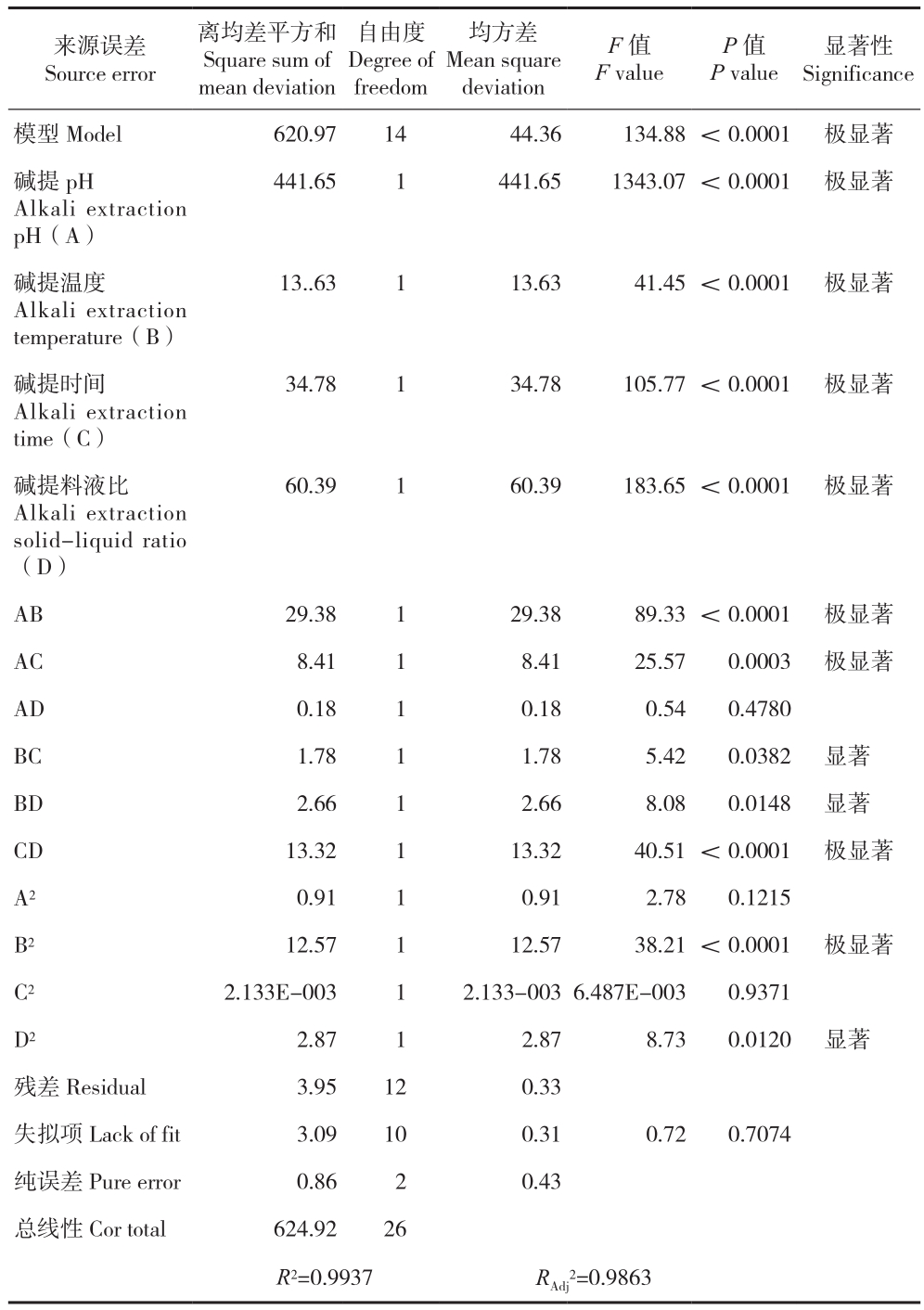
来源误差Source error离均差平方和Square sum of mean deviation自由度Degree of freedom均方差Mean square deviation F值F value P值P value显著性Significance模型Model 620.97 14 44.36 134.88<0.0001 极显著碱提pH Alkali extraction pH(A)441.65 1 441.65 1343.07<0.0001 极显著碱提温度Alkali extraction temperature(B)13..63 1 13.63 41.45<0.0001 极显著碱提时间Alkali extraction time(C)34.78 1 34.78 105.77<0.0001 极显著碱提料液比Alkali extraction solid-liquid ratio(D)60.39 1 60.39 183.65<0.0001 极显著AB 29.38 1 29.38 89.33<0.0001 极显著AC 8.41 1 8.41 25.57 0.0003 极显著AD 0.18 1 0.18 0.54 0.4780 BC 1.78 1 1.78 5.42 0.0382 显著BD 2.66 1 2.66 8.08 0.0148 显著CD 13.32 1 13.32 40.51<0.0001 极显著A2 0.91 1 0.91 2.78 0.1215 B2 12.57 1 12.57 38.21<0.0001 极显著C2 2.133E-003 1 2.133-0036.487E-003 0.9371 D2 2.87 1 2.87 8.73 0.0120 显著残差Residual 3.95 12 0.33失拟项Lack of fit 3.09 10 0.31 0.72 0.7074纯误差Pure error 0.86 2 0.43总线性Cor total 624.92 26 R2=0.9937 RAdj2=0.9863
2.5.3 碱提膳食纤维响应面图分析 由碱提三豆饮豆渣中膳食纤维的响应面图(图10)可知,随着碱提pH、碱提温度、碱提时间、碱提料液比的增加,三豆饮豆渣中膳食纤维含量呈增加趋势,且碱提pH曲线较陡,对响应值影响最为显著,其次为碱提时间、碱提温度,碱提料液比对响应值的影响最小,表现为曲线平缓,图中碱提温度与碱提时间等高线图排列紧密且呈椭圆形,表明碱提温度与碱提时间交互作用较大,其他等高线图表明碱提pH和碱提温度、碱提pH和碱提时间、碱提pH和碱提料液比、碱提温度和碱提料液比、碱提时间和碱提料液比均有交互作用。

图10 碱提三豆饮豆渣中膳食纤维的响应面图(左)和等高线图(右)
Fig. 10 Alkali extraction of dietary fiber from Sandouyin bean dregs in the response surface (Left) and contour plot (Right)
2.5.4 碱提工艺条件的验证 通过对试验模型的分析得到三豆饮豆渣中膳食纤维碱提的最佳条件为:碱提 pH 11.8、碱提料液比1∶35(g/mL)、碱提时间4 h、碱提温度56℃,获得三豆饮豆渣中膳食纤维含量为76.4%,试验重复3次验证,三豆饮豆渣中膳食纤维提取量分别为75.4%、75.9%、75.8%,其平均提取量为75.7%,与理论值偏差小于0.01%,且比三豆饮豆渣最佳酸提条件下获得的膳食纤维含量增加16.6%,比原三豆饮豆渣中膳食纤维含量增加30.1%。说明通过响应面设计优化后得到的最佳条件参数可靠,能较好地预测试验得率。
经检测,酸-碱提取后三豆饮豆渣中各主要成分含量为膳食纤维含量75.7%、蛋白质含量17.9%、豆渣水分含量2.0%、脂肪含量2.5%、灰分含量1.2%。确定三豆饮豆渣中膳食纤维提取的最佳工艺条件为:酸处理条件:酸提 pH 4.6,料液比1∶25(g/mL),酸提时间2.8 h,酸提温度87℃;碱处理条件:碱提 pH 11.8,料液比1∶35(g/mL),碱提时间4 h,碱提温度56℃。
3 讨论
本研究采用单因素和响应面法相结合的方法优化三豆饮豆渣膳食纤维提工艺。从酸提和碱提的单因素试验结果可以看出,料液比和提取时间对豆渣中膳食纤维提取具有饱和性,即随着反应条件水平的提高,膳食纤维含量随之增加,当到达一定程度后,膳食纤维含量达饱和,但不会降低,说明料液比和提取时间对膳食纤维含量没有负面影响。而pH和提取温度对膳食纤维的含量的影响呈现先上升后下降的趋势,说明过度剧烈的条件不仅不能提高膳食纤维含量,反而会破坏其结构,从而降低膳食纤维含量。因此对膳食纤维的提取工艺进行响应面分析很有必要。
本试验结果表明,经酸提后豆渣中膳食纤维的平均提取量为59.1%,比原三豆饮豆渣中膳食纤维含量增加14.4%。经碱提后豆渣中膳食纤维平均提取量为75.7%,比三豆饮豆渣最佳酸提条件下获得的膳食纤维含量增加16.6%,比原三豆饮豆渣中膳食纤维含量增加30.1%。说明整个工艺过程中酸提和碱提对膳食纤维含量提高的贡献同等重要,均可通过降解豆渣中的蛋白质和脂肪从而提高膳食纤维含量。由于酸提和碱提后的处理液对环境污染较大,可通过处理液的酸碱中和减小环境污染。且通过响应面设计优化后得到的最佳条件参数可靠,重复性较好,有利于剩余大量豆渣的循环利用。
4 结论
本研究通过单因素试验结合响应面法对三豆饮豆渣膳食纤维酸提和碱提工艺进行优化,得到最佳酸提和碱提工艺条件如下:酸处理条件为酸提 pH 4.6,料液比1∶25(g/mL),酸提时间2.8 h,酸提温度87℃;碱处理条件为碱提 pH 11.8,料液比1∶35(g/mL),碱提时间4 h,碱提温度56℃。经最佳酸-碱提取后三豆饮豆渣中各主要成分含量为膳食纤维75.7%、蛋白质17.9%、水分2.0%、脂肪2.5%、灰分1.2%。本研究建立了三豆饮豆渣膳食纤维酸提和碱提模型,显著提高了三豆饮豆渣膳食纤维得率,为三豆饮残余的大量豆渣提供了再利用依据。
[1] 肖燕,叶梅惠. 桑菊. 三豆饮合芍药甘草汤治疗老年带状疱疹42例[J]. 云南中医中药杂志,2016, 37(7):97. doi:10. 16254/j. cnki.53-1120/r. 2016. 07. 047.XIAO Y, YE H S J. 42 cases of senile herpes zoster treated with San Dou Yin and Shaoyao liquorice decoction[J]. Yunnan Journal of Traditional Chinese Medicine, 2016, 37(7):97. doi:10. 16254/j.cnki. 53-1120/r. 2016. 07. 047.
[2] 许曼理. 加味三豆饮治疗面部黄褐斑454例[J]. 上海中医药杂志,1988(4):28. doi:10. 16305/j. 1007-1334. 1988. 04. 019.XU M L. 454 cases of facial chloasma treated with modified sandouyin[J]. Shanghai Journal of Traditional Chinese Medicine, 1988(4):28. doi:10. 16305/j. 1007-1334. 1988. 04. 019.
[3] 余日棍. 三豆饮加减治小儿高热验案2则[J]. 浙江中医杂志,2001,36(12):537-537.YU R G. Two cases of children’s high fever treated with sanduoyin[J].Zhejiang Journal of Traditional Chinese Medicine, 2001, 36(12):537-537.
[4] 刘汉兴. 三鲜三豆饮治疗小儿夏季热[J]. 现代中医药,1990(5):48-49. doi:10. 13424/j. cnki. mtcm. 1990. 05. 027.LIU H X. Sanxian sandouyin in the treatment of summer fever in children[J]. Modern Chinese Medicine, 1990(5):48-49. doi:10.13424/j. cnki. mtcm. 1990. 05. 027.
[5] 龙军颖,刘晓鹰. 刘晓鹰教授运用三豆饮治疗小儿本气自病发热经 验[J]. 中医 儿 科 杂 志,2019, 15(1):18-20. doi:10. 16840/j.issn1673-4297. 2019. 01. 07.LONG J Y, LIU X Y. Professor LIU Xiaoying’s experience in the treatment of pediatric fever due to underdevelopment of of visceral qi by Sandouyin[J]. Journal of Pediatrics of Traditional Chinese Medicine, 2019, 15(1):18-20. doi:10. 16840/j. issn1673-4297.2019. 01. 07.
[6] 柳伟. 三豆饮加减治疗肾病综合征30例[J]. 陕西中医, 2008, 29(4):406-407.LIU W. 30 cases of nephrotic syndrome treated with sanduoyin[J].Shaanxi Traditional Chinese Medicine, 2008, 29(4): 406-407.
[7] 黎杏群,彭潜,赵玉秋,向跃前,易振佳. 银花三豆饮配合其它药物治疗急性中毒[J]. 中西医结合医学,1988(4):225-256 LI X Q, PENG Q, ZHAO Y Q, YI Z J. Yinhua sandouyin combined with other drugs in the treatment of acute poisoning[J]. Integrated Traditional Chinese and Western Medicine,1988(4):225-256.
[8] 容月庆,沈海辉,何洋,刘桂莲,孙悦. 三豆饮抗氧化活性的研究[J].广东化工,2016, 43(5):30,18.RONG Y Q, SHEN H H, HE Y, LIU G L, SUN Y. Study on antioxidative activities in different fractions from Three-soybean Liquid[J].Guangdong Chemical Industry, 2016, 43(5):30,18.
[9] 沈海辉,容月庆,何洋,杨泽军,李思敏,孙悦. 三豆饮抗氧化活性的研究Ⅱ[J]. 广东化工 , 2016, 43(5):31,46.SHEN H H, RONG Y Q,HE Y, YANG Z J, LI S M, SUN Y. Study on antioxidant capacity of Three-soybean Liquid Ⅱ[J]. Guangdong Chemical Industry, 2016, 43(5):31,46.
[10] 杨友鹤 . 阴阳分型辨治糖尿病[J]. 河南中医 , 1999(5):1-2.YANG Y H. Differentiation and treatment of diabetes by Yin and Yang[J]. Henan Traditional Chinese Medicine, 1999(5):1-2.
[11] 王沛,宋启卯,周哲,李秀昌,韩永哲,王伟礼. 绿豆对动物的降血脂作用[J]. 沈阳药学院学报,1990, 7(1):42-44. doi:10. 14066/j.cnki. cn21-1349/r. 1990. 01. 009.WANG P, SONG Q M, ZHOU Z, LI X C, HAN Y Z, WANG W L.Effect of mung bean on reducing blood lipid in animals[J]. Journal of Shenyang Pharmaceutical College, 1990, 7(1):42-44. doi:10.14066/j. cnki. cn21-1349/r. 1990. 01. 009.
[12] 任平国,徐启红. 醇沉法提取豆渣中可溶性膳食纤维的研究[J].中国油脂,2009, 34(3):61-63.XU P G, XU Q H. Extraction of soluble dietary fibre from soybean dregs by alcohol precipitation method[J]. China Oils and Fats, 2009, 34(3):61-63.
[13] 程明明,黄苇. 超声波辅助酶碱法提取西番莲果皮水不溶性膳食纤维的工艺研究[J]. 广东农业科学,2017, 44(5):118-125. doi:10. 16768/j. issn. 1004-874X. 2017. 05. 019.CHENG M M, HUANG W. Extraction of insoluble dietary fiber from Passiflora edulis peel bu ultrasonic auxiliary enzymaticand alkali method[J]. Guangdong Agricultural Sciences, 2017, 44(5):118-125. doi:10. 16768/j. issn. 1004-874X. 2017. 05. 019.
[14] 周录泳,褚夫江,刘文彬,卢雪梅,金小宝,朱家勇. 酶碱结合法制备红薯膳食纤维的工艺研究[J]. 广东农业科学,2015, 42(17):82-89. doi:10. 16768/j. issn. 1004-874X. 2015. 17. 008.ZHOU L Y, ZHU F J, LIU W B, LU X M, JIN X B, ZHU J Y. Dietary fiber preparation from sweet potato by combined technology of enzymolysis with alkaline hydrolysis[J]. Guangdong Agricultural Sciences, 2017, 42(17):82-89. doi:10. 16768/j. issn. 1004-874X.2015. 17. 008.
[15] 蔡炯,许进,倪国强. 肠道菌群与膳食纤维[J]. 肠外与肠内营养,2002, 9(1):50-52.CAI J, XU J, NI G Q. Intestinal flora and dietary fiber[J]. Parenteral and Enteral Nutrition, 2002, 9(1): 50-52.
[16] 安艳霞,董艳梅,张剑,李梦琴. 膳食纤维的功能特性及在食品行业中的应用与展望[J]. 粮食与饲料工业,2019(6):30-33.AN Y X, DONG Y M, ZHANG J, LI M Q. Functional properties of dietary fiber and its application in the food industry[J]. Cereal &Feed Industry, 2019(6):30-33.
[17] 黄才欢,欧仕益,张宁,李亚菲,赵谋明. 膳食纤维吸附脂肪、胆固醇和胆酸盐的研究[J]. 食品科技,2006(5):133-136. doi:10.13684/j. cnki. spkj. 2006. 05. 049.HUANG C H, OU S Y, ZHANG L, LI Y F, ZHAO M M. Research on the adsorption capacity of dietary fiber complexes for fat, cholesterol and Bile acid in vitro[J]. Food Science and Technology, 2006(5):133-136. doi:10. 13684/j. cnki. spkj. 2006. 05. 049.
[18] 陈亚非,赵谋明. 水溶性与水不溶性膳食纤维对油脂胆固醇和胆酸钠吸附作用研究[J]. 现代食品科技,2005(3):58-60. doi:10.13982/j. mfst. 1673-9078. 2005. 03. 019.CHEN Y F, ZHAO M M. Adsorption capacity of dietary fiber complexes for fat, cholesterol and bile acid in vitro[J]. Modern Food Science and Technology, 2005(3):58-60. doi:10. 13982/j. mfst. 1673-9078. 2005. 03. 019.
[19] 刘锐雯. 木薯膳食纤维的提取工艺及理化性质的研究[D]. 厦门:厦门大学, 2014.LIU R W. Study on extraction process and physical and chemical properties of cassava dietary fiber[D]. Xiamen: Xiamen University,2014.
[20] SANDERG A S, ANDEMNIE R J . Effects of content on Zinc absorption in product extruded-bran product[J]. Food Sicence , 1986(51):547-550 .
[21] 田成. 不溶性豆渣膳食纤维改性工艺及物化特性研究[D]. 恩施:湖北民族学院,2010.TIAN C. Study on the modification process and physichemical properties of soybean residue insoluble dietary fiber[D]. Enshi:Hubei Minzu University, 2010.
[22] 张媛媛,宣丽,吕美,何欢. 双酶法提取小麦麸皮膳食纤维的工艺研究[J]. 粮食与食品工业,2019, 26(4):36-40.ZHANG Y Y, XUAN L, LU M, HE H. Study on the extraction of dietary fiber from wheat bran by double enzyme method[J]. Grain and Food Industry, 2019, 26(4):36-40.
[23] 宋真真. 豆渣膳食纤维的制备及其降血糖功能与面条工艺优化研究[D]. 杨凌:西北农林科技大学,2014.SONG Z Z. Research on bean dregs dietary fiber noodles and its hypoglycemic function[D]. Yangling:Northwest A&F University,2014.
[24] 贾立冬. 膳食纤维在食品中的应用进展[J]. 农产品加工, 2019(13):89-90.doi:10. 16693/j. cnki. 1671-9646(X). 2019. 07. 023.JIA L D. Application progress of dietary fiber in food[J]. Farm Products Processing, 2019(13):89-90. doi:10. 16693/j. cnki.1671-9646(X). 2019. 07. 023.
[25] 潘建刚,黄苗苗,张艾艾. 酶-化学法提取荞麦壳中水不溶性膳食纤维的工艺优化[J]. 广东农业科学,2015, 42(3):85-88. doi:10.16768/j. issn. 1004-874X. 2015. 03. 010.PAN J G, HUANG M M, ZHANG A A. Optimization of insoluble dietary fiber extraction from buck wheat shell by enzymatic-chemical method[J]. Guangdong Agricultural Sciences, 2015, 42(3):85-88. doi:10. 16768/j. issn. 1004-874X. 2015. 03. 010.
[26] 叶秋萍,曾新萍,郑晓倩. 膳食纤维的制备技术及理化性能的研究进展[J]. 食品研究与开发,2019, 49(17):212-217.YE Q P, ZENG X P, ZHEN X Q. Research progress on preparation technology and physicochemical properties of dietary fiber[J]. Food Research and Development, 2019, 49(17):212-217.
[27] RAKVAAG E, FUGLSANG N R. Whey protein combined with low dietary fiber improves lipid profile in subjects with abdominal obesity:A randomized, controlled trial. [J] . Nutrients, 2019, 11(9):1-33.doi:10. 3390/nu11092091.
[28] 苟青松,胡伟,王展,秦先魁,沈汪洋,刘零怡,李芳. 添加豆渣对苏打饼干制作过程及品质的影响[J]. 食品工业科技,2019,40(16):39-44. doi:10. 13386/j. issn1002-0306. 2019. 16. 007.GOU Q S, HU W, WANG Z, QING X K, SHEN W Y, LIU L Y,LIF. The effect of soybean dregs on the processing and quality of soda biscuits[J]. Science and Technology of Food Industry, 2019, 40(16):39-44. doi:10. 13386/j. issn1002-0306. 2019. 16. 007.
[29] KHAYRA M, SAMIRA B, HAFIDA M, FATIMA Z B A, MERYEM B, NESRINE S K, WACILA N, SELMA B R. Effect of dietary fiber on oxidative status and lipid profile in aged diabetic rats[J]. Archives of Cardiovascular Diseases Supplements, 2019, 11(3):359-360. doi:10. 1016/j. acvdsp. 2019. 05. 062.
[30] 傅昌芳,朱翠红,沈爱宗,唐丽琴,刘圣. 免疫营养素抗恶性肿瘤作用及其临床应用[J]. 中国病原生物学杂志,2019, 14(6):735-738.doi:10. 13350/j. cjpb. 190626.FU C F, ZHU C H, SHEN A Z, TANG L Q, LIU S. The effect of immune-modulating nutrients on malignant tumors and their clinical use[J]. Journal of Pathogen Biology, 2019, 14(6):735-738. doi:10. 13350/j. cjpb. 190626.
[31] 佐兆杭. 大豆膳食纤维对糖尿病大鼠血糖、胰腺损伤及卵巢衰老的影响[D]. 大庆:黑龙江八一农垦大学,2019.ZUO Z H. Effects of soybean dietary fiber on blood glucose, pancreatic injury and ovarian aging in diabetic rats[D]. Daqing:Heilongjiang Bayi Agricultural University, 2019.
[32] 中华人民共和国卫生部. GB/T5009. 6-2016食品中脂肪的测定[S].北京:中国标准出版社,2017.Ministry of health of the people’s Republic of China. Determination of fat in food(GB /T5009. 6-2016)[S]. Beijing: China Standards Press, 2017.
[33] 中华人民共和国卫生部. GB/T5009. 5-2016食品中蛋白质的测定[S].北京:中国标准出版社, 2017.Ministry of Health of the People’s Republic of China. Determination of protein in food(GB / T5009. 5-2016)[S]. Beijing: China Standards Press, 2017.
[34] 中华人民共和国卫生部. GB/T5009. 3-2016食品中水分的测定[S].北京:中国标准出版社,2017.Ministry of Health of the People’s Republic of China. Determination of water content in food(GB / T5009. 3-2016)[S]. Beijing: China Standards Press, 2017.
[35] 中华人民共和国卫生部. GB/T5009. 4-2016食品中灰分的测定[S].北京:中国标准出版社,2017.Ministry of Health of the People’s Republic of China. Determination of ash in food(GB / T5009. 4-2016)[S]. Beijing:China Standards Press, 2017.
[36] 中华人民共和国卫生部. GB/T5009. 88-2008食品中膳食纤维的测定[S]. 北京:中国标准出版社,2017.Ministry of Health of the People’s Republic of China. Determination of dietary fiber in food(GB / T5009. 88-2008)[S]. Beijing:China Standards Press, 2017.
[37] 李文佳. 豆渣膳食纤维提取及其在面包中的应用[D]. 长沙:湖南农业大学,2008.LI W J. Extraction of dietary fiber from soybean dregs and its utilazition in bread[D]. Changsha:Hunan Agricultural University, 2008.
[38] 邓强,杨宏,罗忠圣,徐昌艳,袁小亮,钱志瑶,覃容贵. 响应面法优化“三豆饮”水提工艺及其抗氧作用研究[J]. 食品科技,2018, 43(11):251-259. doi:10. 13684/j. cnki. spkj. 2018. 11. 041.DENG Q, YANG H, LUO Z S, XU C Y, YUAN X L, QIAN Z Y, QIN R G. Optimization of the water extraction process of triple bean potion by response surface methodology and its antioxidants activities[J]. Food Science and Technology, 2018, 43(11):251-259. doi:10. 13684/j.cnki. spkj. 2018. 11. 041.
[39] 包怡红,冯雁波. 响应面试验优化红松松仁膳食纤维制备工艺及其理化性质分析[J]. 食品科学,2016, 37(14):11-17.BAO Y H, FENG Y B. Dietary fiber from pine kernel meal:Optimization of extraction process by Response Surface Methodology and physicochemical properties[J]. Food Science, 2016, 37(14):11-17.
[40] 费亚芬,王玉婷,陆夏逸,劳梦,李颖豪,张拥军. 海藻膳食纤维提取工艺优化及其对小鼠肠道菌益生作用[J]. 海南师范大学学报(自然科学版),2019, 32(1):54-63.FEI Y F, WANG Y T, LU X Y, LAO M, LI Y H, ZHANG Y J. Extraction and optimization of marine algae dietary fiber and its effects on mice intestinal microflora[J]. Journal of Hainan Normal University(Natural Science), 2019, 32(1):54-63.